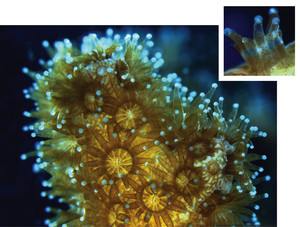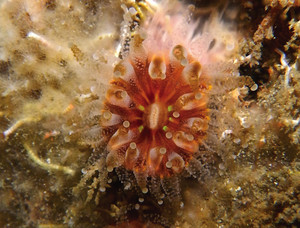
Vanessa Marcelino / University of Melbourne
Great Barrier Reef in Australia: genetic mapping identified diversity of microorganismsVanessa Marcelino / University of MelbourneCoral reefs are known for the wide variety of species that live in their environs. Anchored to the seabed, where they build enormous colonies, corals—animals related to jellyfish—are normally surrounded by colorful algae and fish, in addition to countless microorganisms, all of which form large ecosystems. For most shallow-water corals, however, no other living creature is more important than the zooxanthellae, a group of microscopic algae that live inside them and function like true organs. Zooxanthellae recycle substances excreted by corals, such as ammonium, and release food in the form of sugars, thus ensuring their own survival as well as that of their hosts, which do not have the resources to carry out these physiological processes. Two studies show that this association dates back at least 210 million years, and that symbiotic algae are even older than that—and much more diverse.
In a comparison of present-day corals from Brazil with fossils that lived in the Tethys Ocean, which existed when the continents formed a single block known as Pangaea, a group of researchers from Poland, Switzerland, the United States and Brazil successfully showed that this relationship already existed in the Triassic Period, 210 million years ago, when the dinosaurs emerged. According to the researchers, symbiosis ensured that the corals became capable of surviving during a time when the water of the Tethys Ocean was nutrient-poor. “These algae intrinsically need light and carbon dioxide to perform photosynthesis and produce their own food. During that process, they recycle substances that are harmful to the corals, and they also provide sugars and lipids,” explains oceanographer Marcelo Kitahara, a professor in the Department of Ocean Sciences at the Federal University of São Paulo (Unifesp), who is also a collaborating researcher at the Center for Marine Biology at the University of São Paulo (CEBIMar-USP) and a coauthor of the paper published in November 2016 in Science Advances.
Corals of the past
There is no telling how many algae lived in the corals long ago, but it is possible to infer their presence through the signature left by a combination of chemical elements deposited when the corals were still alive more than 200 million years ago. Different types (isotopes) of carbon, oxygen and nitrogen were detected because of the excellent state of preservation of fossils collected in Antalya Province in Turkey, in a mountainous region once covered by the Tethys Ocean. “Luckily, the rocks were well-isolated from the water, which normally penetrates them,” says geologist Jaroslaw Stolarski of the Polish Academy of Sciences in Warsaw, a coauthor of the paper in Science Advances. Water contributes to the diagenesis of rocks, which in this case involves the transformation of aragonite, a mineral rich in fossil information, into calcite, which is of little or no use to specialists. “If we want to extract original information from a coral skeleton, it has to be well-preserved. The presence of aragonite is evidence of such preservation because it contains all the original isotopic signatures,” he explains.

Jaroslaw Stolarski / Polish Academy of Sciences
Fossil coral from the Triassic…Jaroslaw Stolarski / Polish Academy of SciencesThe researchers then compared the isotopes found in the fossils against those present in symbiotic and asymbiotic corals currently found on the island of Búzios, in the Ilhabela Archipelago in the state of São Paulo. “To make this comparison, we needed to have not only well-preserved fossils, but also present-day corals living under the same conditions of water luminosity and temperature, food availability, and other factors,” says Kitahara. After an extensive search, the group found a very diverse community in local waters, living in a space only five square meters (m2) large. This was the only way to minimize the probability that other factors could influence the presence of certain isotopes.
The analyses showed that both the fossils and the present-day symbiotic corals have the same types of carbon, nitrogen and oxygen. The difference is striking when compared to modern corals that do not carry out symbiosis, and they do not have the same isotopes. The reason for their presence in symbiotic corals is not fully understood, but scientists do know, for example, that a type of nitrogen present in symbiotic corals derives from the ammonium excreted by the coral and absorbed by the zooxanthellae.
The findings are bolstered by another analysis involving the growth microstructure of corals. The researchers started from the premise that symbiotic corals of the past grew the same way as those living today in association with microorganisms: with continuous regularity, since their metabolism is linked to that of the algae that live inside them and depend on sunlight to perform photosynthesis. “The microstructures record the physiological rhythm of the corals. Symbiotic corals generally follow the rhythm of the algae, while asymbiotic corals do not follow periods of presence or absence of sunlight,” Stolarski explains. Asymbiotic corals, therefore, have an irregular growth pattern, while symbionts are quite regular and follow day/night periods.

Isabelle Domart-Coulon / Museum of Natural History, Paris
…and living specimen, with activity of symbiotic algae at brown spots (see inset)Isabelle Domart-Coulon / Museum of Natural History, ParisPresent-day algae
The algae that live inside corals, however, already existed well before them. A genetic mapping of the currently-existing microbiome in the skeletons of symbiotic corals in the Great Barrier Reef of Australia, the world’s largest formation of this type, tracked the existence of several algal lineages back as far as the Ordovician Period, about 500 million years ago. “In addition to the fact that they are older, we’ve now discovered that they are much more diverse than previously thought,” explains Brazilian biologist Vanessa Rossetto Marcelino, who is now completing her doctoral studies at the University of Melbourne, Australia. She and her advisor, biologist Heroen Verbruggen, have coauthored a paper published in Scientific Reports in August 2016. Marcelino analyzed DNA drawn from skeleton samples of living corals and found more than a hundred of what may be new species, or even entire lineages, of algae.
While corals are visible to the naked eye and have been abundantly studied, little is known about algae. The reason for this still-nascent understanding is the difficulty in identifying the difference between algal species, either with a microscope or through genetic sequencing. “Their format is always the same, and the existing molecular markers are low-resolution; in other words, they don’t serve to identify much of the biodiversity,” Marcelino explains.
Therefore, she and Verbruggen used a combination of four markers to analyze the DNA extracted from 132 coral skeleton samples. That effort enabled them to identify an array of organisms, many of which had never before been found in corals. In addition to algae, which constitute the largest part of this microbiome, a number of fungi and bacteria were also detected. Although the scientific literature accounted for a few coral-dwelling species, the researchers in Australia found more than 120, including entire families not yet described. The diversity they found also suggests that some lineages are even older than the corals themselves, and already existed 250 million years before they began to inhabit these organisms. Fossil analyses had already shown evidence of the presence or these creatures in shells and stromatoporoids—sea sponges that lived some 500 million years ago. “Corals have been invaded by more than 20 different lineages of algae at different times during their evolution,” Marcelino says.

Marcelo Kitahara / Unifesp
Found along nearly the entire Brazilian coastline, Astrangia rathbuni is an example of asymbiotic coralMarcelo Kitahara / UnifespThe algal genus Ostreobium, which until then was believed to encompass three species, proved in fact to be a lineage having more than 80 taxonomic units, a near-species level of classification. In their 500 million years of existence, they even survived the mass extinction of the Permian Period, approximately 300 million years ago, when nearly 90% of marine species and 70% of terrestrial species disappeared from the Earth. Soon afterward, in the Triassic Period, they diversified, precisely at the time that symbiotic corals emerged. In addition to showing the effectiveness of using multiple markers to study the microbiomes inside corals, the discovery opens the door to more-specific research into the creatures that inhabit coral skeletons and the role they play in their lives.
Marcelino and her research colleagues in Australia are already applying the multiple-marker sequencing methodology to study whether different coral species are associated with specific algal lineages. In addition, they want to know how the association between these organisms changes according to ecological conditions and the species involved. “We’ve opened a book, and now we’ll be able to study the pages inside it,” Marcelino concludes.
Scientific articles
FRANKOWIAK, K. et al. Photosymbiosis and the expansion of shallow-water corals. Science Advances. 2: e1601122. November 2, 2016.
MARCELINO, V. R. & VERBRUGGEN, H. Multi-marker metabarcoding of coral skeletons reveals a rich microbiome and diverse evolutionary origins of endolithic algae. Scientific Reports. 6: 31508. August 22, 2016.
